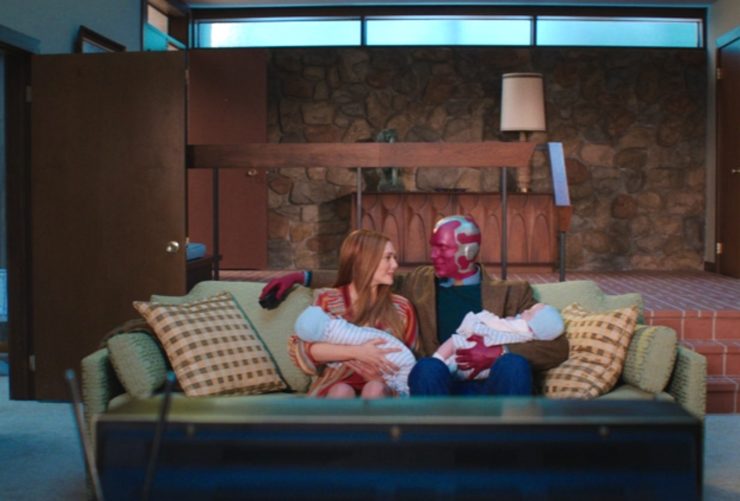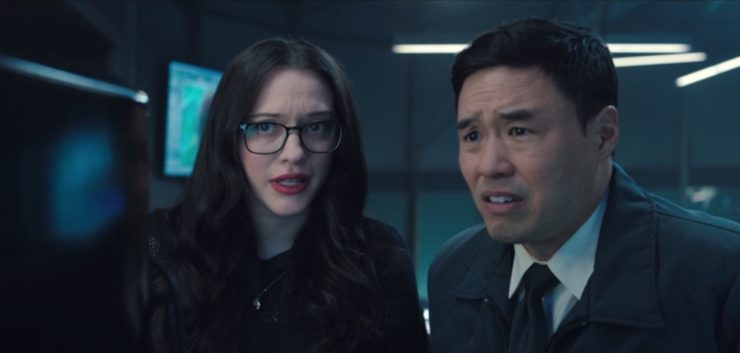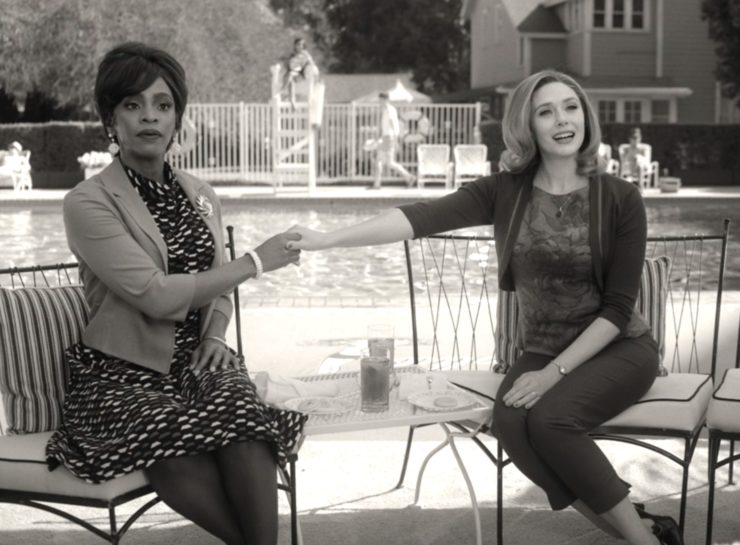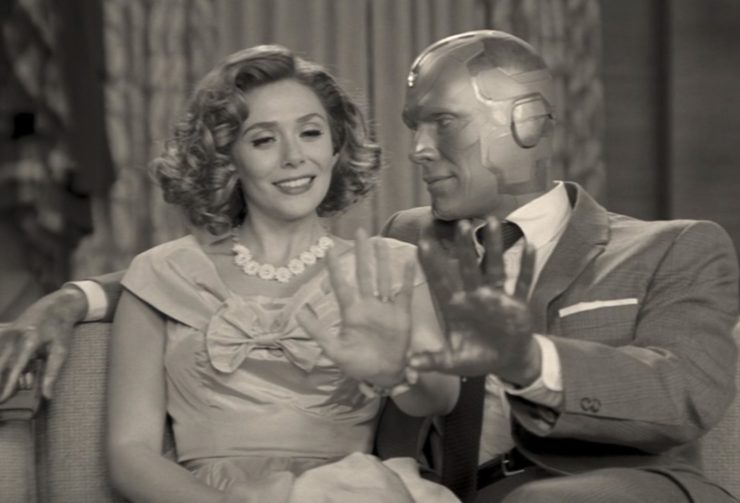The first (of many) Marvel Cinematic Universe offerings on Disney+, WandaVision has, over the course of its first four episodes, mined several different histories: the history of sitcoms in America, the comics histories of its various characters, and the history of the MCU. Let’s dig into those histories, and how the show’s writers are using them to build their own distinct versions of the characters…
SPOILERS for WandaVision episodes 1-4 and probably other MCU productions, not to mention a passel of comics…
The sitcom history has been pretty well dissected by various articles and reviews and thinkpieces already, though I will say that I love how it’s mixing and matching from so many sources. The visuals of episode 1 were very much The Dick Van Dyke Show, but the plot, with Wanda trying to hide her magic from the neighbors, was straight out of Bewitched and I Dream of Jeannie. And then episode 2 was a much more overt riff on Bewitched, but it also had a pretty standard sitcom setting of attempting to do something simple that goes horribly wrong—one particularly used on Dick Van Dyke as well as I Love Lucy and so many others.
What’s more impressive is how many different inspirations the storyline is taking from the comics.
The notion of Vision and the Scarlet Witch (the codename used by Wanda Maximoff in the comics since her first appearance in X-Men #4 in 1964 by Stan Lee & Jack Kirby, but which has never been used in the MCU) becoming a happy suburban couple dates back to shortly after their departure from the Avengers in Avengers #211 by Jim Shooter & Gene Colan in 1981. By that time, the pair had been with the team since Avengers #76 by Roy Thomas & John Buscema in 1970, having met in that issue when Wanda rejoined the team, and gotten married in Giant-Size Avengers #4 by Steve Englehart & Don Heck in 1975.
So having the pair of them leave was a major change. (Two other long-standing Avengers, the Beast and Wonder Man, also departed in issue #211.) They’d been mainstays of the team for more than a decade. But they wanted to try to live normal lives, and so they moved to the suburbs: Leonia, New Jersey, where they lived during both of the 1980s Vision & The Scarlet Witch miniseries—the four-issue one in 1982 by Bill Mantlo & Rick Leonardi and the twelve-issue one by Englehart & Richard Howell in 1985.

The latter miniseries is of particular note for WandaVision because it was in the Englehart/Howell comic that Wanda became pregnant and gave birth to twin boys, named Tommy and Billy (just like in the TV show). However, the twins were later revealed, in an Avengers West Coast storyline by John Byrne in 1989 to be figments of her imagination made real, in part due to manipulation by the demon Mephisto (who is more or less the Marvel Universe equivalent of Satan).
That was just the start of Wanda’s ability to manipulate reality. In Kurt Busiek & George Pérez’s run on the Avengers comic in 1998, Wanda’s powers were able to resurrect Wonder Man, who’d been killed in Force Works #1 in 1994 by Dan Abnett, Andy Lanning, & Tom Tenney. The entire House of M storyline by Brian Michael Bendis & Oliver Coipel in 2005 was started by Wanda warping reality to a world where mutants were in the majority, and then partway through the same storyline, Wanda turned 90% of mutants in the Marvel Universe into normal humans.
Buy the Book


Defekt
But the two 1980s Vision/Witch miniseries weren’t the only time we saw these characters try to live normal lives in suburbia and fail. In the Vision twelve-issue miniseries by Tom King & Gabriel Hernandez Walta in 2015, Vision creates a nuclear family, constructing a synthozoid wife and two synthozoid children, but their attempts to live a normal life are pretty well dashed.
We still don’t know the extent of what’s happening in WandaVision, but episode 4 made it clear that the weird sitcom world they’re occupying is of Wanda’s own creation and she has a certain amount of control over it, much as she did the House of M setting. And she’s resurrected people from the dead before in the comics—she’s done it with the Vision, with Wonder Man, and with her brother Quicksilver. And the comics character has a history of mental issues and instability, including being possessed by the demon Chthon (in Avengers #185-187 by Mark Gruenwald, Steven Grant, David Michelinie, & Byrne in 1979), a massive mental breakdown after the Vision was dismantled and resurrected and she found out her children weren’t real in Byrne’s run on Avengers West Coast ten years after that, and then another breakdown that nearly destroyed the Avengers in 2004’s Avengers #500 by Bendis & David Finch, with subsequent issues in the “Disassembled” storyline, and then House of M.
One of the challenges of creating new versions of characters who have many decades of history in their original form is finding a way to distill that history into a single storyline. After all, prior to WandaVision, the only appearances of the two characters are in a small handful of movies (Avengers: Age of Ultron, Captain America: Civil War, Avengers: Infinity War, and, for Wanda on her own, Avengers: Endgame plus a cameo at the end of Captain America: The Winter Soldier). Yet Jac Schaeffer and her writing staff have done an excellent job making use of those bits of history as the springboard for this storyline—
—which also has its roots in the decade-plus of MCU material. Wanda and Vision first became romantically interested in each other in Civil War, and had been seeing each other clandestinely between that movie and Infinity War. Elizabeth Olsen and Paul Bettany did a remarkable job in those two movies selling a relationship that largely happened between those two films, so that Wanda’s anguish at Vision’s death is very real, not just in Endgame when she attacks Thanos, but in her desire to manufacture a happily-ever-after for the two of them in WandaVision.

We also have three additional supporting characters from the MCU: Darcy Lewis (Kat Dennings) from the first two Thor movies, Jimmy Woo (Randall Park) from Ant-Man & The Wasp, and Monica Rambeau (Teyonah Parris), all growed up after being seen as a kid in Captain Marvel (played by Akira Akbar in the movie, who very much looks like she could grow up to be Parris).
Darcy has a doctorate in astrophysics now, which is simply fabulous, though she’s lost none of her sass in the decade-plus since Thor. Honestly, I could just watch her and Woo commenting on Wanda and Vision’s life for the next five weeks. Heck, make those two the Statler and Waldorf of the entire MCU going forward!
As for Rambeau, she’s a character with quite a fascinating history, as she was groundbreaking in her initial appearance in 1982 in Amazing Spider-Man Annual #16 by Roger Stern & John Romita Jr. as the new Captain Marvel, and who became a major player in the Avengers during Stern’s run on the team book in the 1980s. A rare woman of color as a superhero, and an even rarer (at the time) person of color whose skin tone wasn’t an explicitly stated part of their character (for example, through the use of “Black” as a prefix for the codename, à la Black Goliath, Black Lightning, Black Panther, etc.), Rambeau was a strong, powerful character, and an impressive successor to the Captain Marvel name following the death of the Kree Mar-Vell in The Death of Captain Marvel by Jim Starlin, also in 1982.
Mar-Vell’s son taking on the name Captain Marvel meant Rambeau had to change her codename (she’s been Spectrum and Photon, among others), but she’s still a great character, and it’s a joy to see her in the MCU. The writers have even given her the rank of captain, and made her mother Maria (a creation of the MCU for Captain Marvel) the founder of S.W.O.R.D.
Loosely based on the comics organization that was originally part of S.H.I.E.L.D., the Sentient World Observation and Response Division seems to be taking over S.H.I.E.L.D.’s former function in the MCU prior to The Winter Soldier, and was founded by Maria Rambeau following her best friend turning into a cosmic superhero in the 1990s.

The best use of the MCU’s history in the show, though, came at the top of episode 4, where we find out that Monica Rambeau was among the half of humanity who was dusted by Thanos at the end of Infinity War, and then restored five years later by the Hulk in Endgame. The latter movie didn’t really have the storytelling space to devote to how it was for all these people to come back. Spider-Man: Far from Home did pay some lip service to it, at least, but it was a minor part of the storyline. It was the opening of the fourth episode of WandaVision that really dug into what the experience was like, and did so in less than seven minutes out of a half-hour episode.
There are still several more decades’ worth of sitcoms to explore—can’t wait to see what they do with the likes of Full House, The Cosby Show, Family Ties, Married…with Children, Roseanne, and so on—but I also fear this is not likely to end happily. One thing all Vision and Scarlet Witch’s attempts to live normal lives have in common is that they ended rather nastily with them being dragged back into the world of superheroics—often accompanied by tragedy. Their first house in Leonia was burned to the ground by anti-mutant rioters, and their second home came to an end when government agents dismantled Vision. Vision’s own attempts to have a simple suburban life with his synthozoid family has resulted only in horrendous tragedy.
Doesn’t really bode well for Wanda and Vision, does it? Especially if they decide to give us the MCU equivalent of Mephisto…
Keith R.A. DeCandido has been writing about pop culture for Tor.com since 2011, including “4-Color to 35-Millimeter: The Great Superhero Movie Rewatch,” which covers every live-action movie based on a superhero comic book, and the current Star Trek: Voyager Rewatch. Indeed, most of his writing for this site is either about comics adaptations or Star Trek. He’s also a prolific fiction writer, with recent books including A Furnace Sealed (first in an urban fantasy series that he’s working on the sequel to), Alien: Isolation (based on the movie series and the video game), Mermaid Precinct (latest in his ongoing fantasy/police procedural series), To Hell and Regroup (a military SF novel written with David Sherman), and Animal (a thriller written with Dr. Munish K. Batra).











I have to admit I only skimmed the comics part because I’m realizing I really don’t WANT to theorize too much – I like being taken along for the ride and not knowing what is going to happen. The MCU movies are a little predictable – not in a bad way, but I can just generally figure out what the shape of the narrative is going to be in broad strokes. They do it well, so it doesn’t hamper my enjoyment of what it is, but I’m also really enjoying really having no idea where this story is going.
The MCU movies are a little predictable – not in a bad way, but I can just generally figure out what the shape of the narrative is going to be in broad strokes.
Yeah, I said this back during Keith’s Superhero Rewatch, but that was one element of Endgame that made it more enjoyable than Infinity War for me.
With Infinity War, I knew the Snap was coming between a combination of comics knowledge and basic narrative storytelling 101. We’d known since the announcement in 2014 that the film was a duology with Endgame and so you end the first chapter on a cliffhanger. But even knowing that was how the film would likely end, it was still a shock because part of me didn’t think Marvel Studios would have the cajones to actually do it.
With Endgame, yeah we know the basic outcome (Thanos is defeated, Snap is undone). But since Feige kept the Phase Four announcement until after the film’s release, we didn’t know if any of the Avengers would survive (and likewise whether any of the pre-Snap Thanos victims like Gamora, Loki, Heimdall, or Vision would be resurrected either). There was genuine tension.
Speaking of Full House:
Wouldn’t it be great if they did a ’80’s riff on that show and had a cameo by a certain pair of twin sisters?
@krad: I believe the show says that S.W.O.R.D. is the Sentient Weapon Observation and Response Division, not World.
I’m still waiting for the episode where they get wear their classic comic costumes, presumably the Halloween episode that so many sitcoms did so well. And I have a ton of anticipation for how this will tie in to the new Dr Strange film.
@3 I mentioned that in one of the rewatches. I would love it, especially as they’ve been so reluctant to have anything to do with Fuller House (which is totally their perogative) so I would be highly amused if they decided they’d participate in a spoof. They kinda seem over acting at this point though. Maybe they would do it for their sister (not sure if they have a close relationship or not).
@2 The Snap is a great example of something that probably would have been a really shocking, exciting moment but that – in part just from hanging around places like Tor – I knew about years in advance even though I’ve never read a comic. No grudge there, but I’m definitely trying to stay away from some of the comics heavy theorizing this time (although I can’t really avoid it totally).
And while Endgame did have a bit more tension, I guess I still felt like the Un-snap was being telegraphed and that, generally, some way to defeat Thanos would be found. (Not a criticism of the movie – I don’t mind movies following tropes when they are entertaining).
but episode 4 made it clear that the weird sitcom world they’re occupying is of Wanda’s own creation
These sorts of statements irk me, because no that wasn’t made clear. It was made clear that Wanda has some awareness that she is not in the “real world” where Vision remains dead, and that she has some control over her environs, but it is no way indicated that she created this place. As a matter of fact, I would so the show was very careful not to indicate ANYTHING yet about how this place came to be, as that is still to be revealed. My money is still on Sonny Burch.
I also do not get everyone’s desire to see the Olsen twins. They were cute kids, but I’ve never liked them, and since they got some agency over their lives they seem to be very happy leaving acting far behind.
I will again note the symmetry going on with Nick Fury and Maria Rambeau. It seems apparent to me after the events of Captain Marvel, as Fury rose in prominence he brought Maria with him, and she eventually spun off SWORD with his support, splitting their responsibilities. After Fury Blipped, Maria worked to re-direct her agency to fill his shoes, and now two years after her death, an un-Blipped Fury is working in space to fill hers.
@5:
The Snap is a great example of something that probably would have been a really shocking, exciting moment but that – in part just from hanging around places like Tor – I knew about years in advance even though I’ve never read a comic. No grudge there, but I’m definitely trying to stay away from some of the comics heavy theorizing this time (although I can’t really avoid it totally).
Then, heh, I’m gonna keep shtum about some of my thoughts as to the next long-term storyline.
I have ideas as to where Feige’s taking it in the wake of Thanos based on the comics knowledge. But with only WandaVision out now, they’re just that: Ideas. I’m just as much in the dark as you at the moment.
And while Endgame did have a bit more tension, I guess I still felt like the Un-snap was being telegraphed and that, generally, some way to defeat Thanos would be found. (Not a criticism of the movie – I don’t mind movies following tropes when they are entertaining).
Yeah. But the advantage Endgame at least had was in that in-story the characters didn’t know that. They didn’t know the day would be saved or that they get their friends and loved ones back.
It actually kinda goes back to how Stan Lee once said that the key to Marvel storytelling (and it applies to DC Comics as well) is the illusion of change. Each writer is a custodian and no matter what they do and changes they implement, the status quo will always reassert itself to make the characters or teams accessible to the next generation of readers and creators.
Real, lasting change is…not necessarily impossible, but it only happens once in a blue moon (ex. Ed Brubaker and Steve Epting resurrecting Bucky Barnes and re-imagining him as the Winter Soldier). Banner cannot cure his Gamma irradiation, nor will Steve go back to the 1940s because the franchise
For me, this has been one of the core advantages the MCU has over the mainstream comics: It doesn’t have to worry about resetting the Status Quo. It can do permanent, irrevocable, and lasting change to the world and the characters.
And that was part of the appeal of Endgame for me: Seeing a possible ending to the stories of Steve and Tony and Banner that simply isn’t possible in the comics because of the medium. Like I said, we didn’t know if any of them would survive Endgame. Even the Black Widow and Hawkeye projects meant little because we didn’t know if they were set before or after Thanos.
Aeryl: That’s a fair point. Wanda definitely has some control over the world, but that doesn’t mean she created it.
And I like the Maria Rambeau/Nick Fury symmetry, too….
—Keith R.A. DeCandido
@8:
And I like the Maria Rambeau/Nick Fury symmetry, too….
Agreed.
Aeryl, you made a good point there. If that’s indeed where Feige is going with this, then it adds additional context to the Spider-Man: Far From Home post-credits scene (and lays more groundwork for Captain Marvel 2 and the Secret Invasion show).
@7 – I assume you’re thinking Secret War?
The Olsen Twins have long retired from acting. Mary-Kate since 2011 and Ashley since 2004. If they didn’t show up for Fuller House, I would be beyond shocked if they showed up in this show.
@10:
Exactly (and if I’m right, heh, I’d imagine Jonathan Hickman’s gonna be very happy).
Besides Skrulls and Secret War, we know Kang is coming in Ant-man. If viewers thought Endgame was headache inducing time-travel, wait till they throw in quantum dimensions. (What are the odds of getting Micronauts?) Then the post WandaVision multiverse madness in the next Doctor Strange movie.
We also know the Fantastic Four are coming before the X-men are rebooted. I’m wondering if they will make Galactus a Celestial after the Eternals movie amps up the cosmic quotient of the MCU even more.
Btw, thanks Krad for the walk down memory lane of comics I’ve enjoyed over the decades.
We also know the Fantastic Four are coming before the X-men are rebooted.
Which is the absolute right move from Feige.
Reed and company are the Marvel First Family, but their films have never achieved the same success as the X-Men or Spidey.
And the X-Men film franchise needs a break for a while. Let that hiatus build anticipation for not only seeing the Mutants on the big screen again, but seeing them integrated into the MCU.
That being said, we know Ryan Reynolds will continue playing Deadpool, so I imagine he’ll cameo at some point to set up the Mutants return (possibly even as early as Spidey 3).
I’m wondering if they will make Galactus a Celestial after the Eternals movie amps up the cosmic quotient of the MCU even more.
Possibly. Galactus has a great backstory in the comics, but trying to adapt it for film…yeah, they probably will have to take creative liberties akin to adapting Thanos for the end of the Infinity Saga.
“Honestly, I could just watch her and Woo commenting on Wanda and Vision’s life for the next five weeks. Heck, make those two the Statler and Waldorf of the entire MCU going forward!”
Yes!
@13 – Micronauts, if they should appear, will have to be limited to the characters Marvel owns, like Bug and Marionette. Everything else is tied up elsewhere (film rights with Paramount and TV rights allegedly with Netflix).